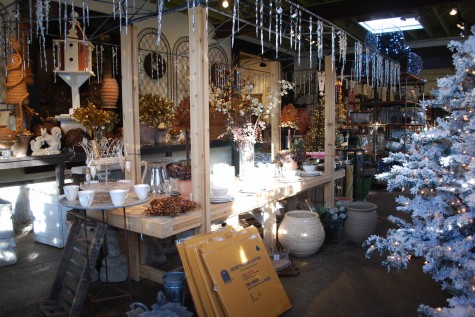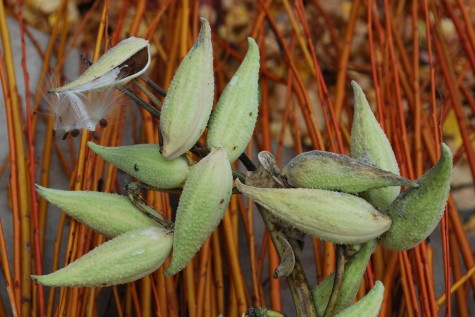
No gardener’s November need be drab. Though the time for planting in ground is drawing to a close, we are just warming up for the late fall, winter, and holiday seasons. Since the winter season in Michigan is every bit as long as the summer, why not celebrate it? We have made a specialty of making all manner of natural materials available to anyone for whom a pot sitting empty and forlorn all winter is not an option. The fantail willow I discussed last week has other equally beautiful relatives. Shrub form dogwood branches are available in a wide range of colors-and I do mean color. Should I ever decide to take up farming, I think I would grow shrubs for their twigs, and milkweeds. The above picture of flame willow and milkweeds is just one idea aimed at decorating November.

I do have curly willow trees on my shop property. They can be a headache, dropping twigs constantly; one 30 foot tree fell flat to the ground on a very windy day. But what makes them bad also makes them good. We topped that tree at six feet, dragged it upright with a truck and chain, and replanted the exposed portion of its rootball; it is back to growing just fine now. The willows take very well to hard pruning, and provides us with a source of brilliantly colored branches. Barely worth a glance in leaf, the bare branches are luscious in color, form and texture.
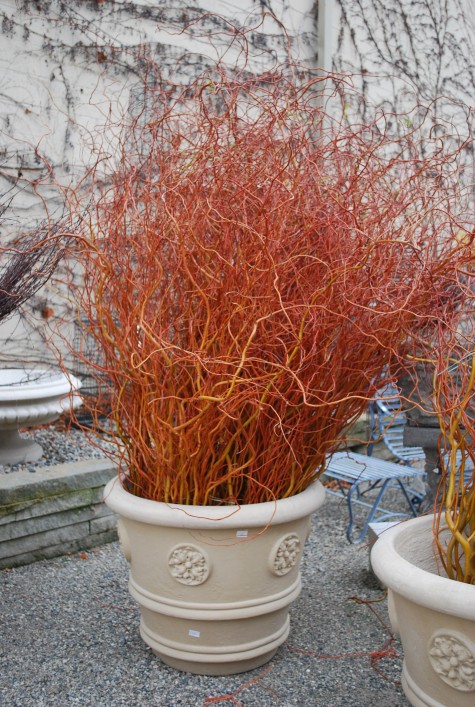
Copper red curly willow-the name says it all. As the new growth has the best color, regular pruning is key. This fresh growth is known as the coppice wood. The stout branches that make up our hazelwood fence panels are harvested in the same way.
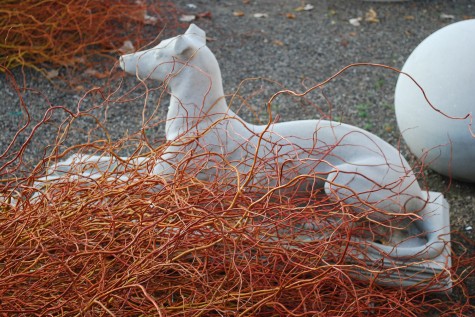 The golden coppery orange is a great foil for the landscape gone to black and white. The fresh branches are limber and pliable. The curly tops can be tied up in a good approximation of a pony tail, or twisted and tied into new shapes not necessarily natural, and perhaps more contemporary.
The golden coppery orange is a great foil for the landscape gone to black and white. The fresh branches are limber and pliable. The curly tops can be tied up in a good approximation of a pony tail, or twisted and tied into new shapes not necessarily natural, and perhaps more contemporary.

Red bud willow comes bundled ten stems to a bunch, and ten bunches to a bale. The stems are straight; the color is good top to bottom. It’s clear these plants are being grown specifically for harvest. Left outside in a pot all winter, the buds will break in the spring. This pussy willow will look great from November on into the following May. Many of the willow stems will root, if they are stuck in soil in a pot. If you arrange all of your materials in dry floral foam as I do, sometimes a fresh cut and a well watered spot in the garden will produce rooting.
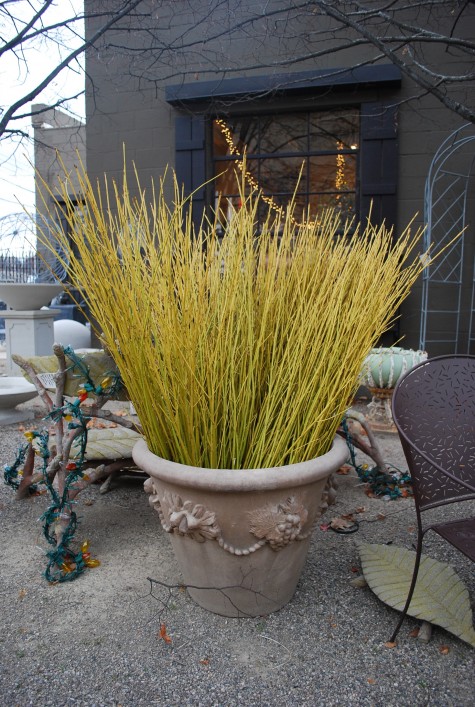 The shrubby dogwoods are every bit as useful as the willows. They also produce the best color on new wood. If you grow these dogwoods in your garden, be sure to prune them down regularly and hard. The old bark of shrubby dogwoods is dull, and invariably scarred by exposure to weather. I rarely see yellow twig dogwood planted any more-plants do go in and out of fashion. This cultivar was specifically bred for color superior to the species- and it delivers.
The shrubby dogwoods are every bit as useful as the willows. They also produce the best color on new wood. If you grow these dogwoods in your garden, be sure to prune them down regularly and hard. The old bark of shrubby dogwoods is dull, and invariably scarred by exposure to weather. I rarely see yellow twig dogwood planted any more-plants do go in and out of fashion. This cultivar was specifically bred for color superior to the species- and it delivers.
 Many cultivars of red twig dogwood are available now. With bark ranging in color from pink-coral to coral, orange red, fire engine scarlet red, and maroon, these twigs make quick work of banishing the winter gardening blues. This cultivar, aptly named “Cardinal” is the brightest red bark I have ever seen. The 1500 stems in this crate makes me wish I could see the entire field from which they were cut-the day the leaves drop. I would bet that view is a perfect gardening moment.
Many cultivars of red twig dogwood are available now. With bark ranging in color from pink-coral to coral, orange red, fire engine scarlet red, and maroon, these twigs make quick work of banishing the winter gardening blues. This cultivar, aptly named “Cardinal” is the brightest red bark I have ever seen. The 1500 stems in this crate makes me wish I could see the entire field from which they were cut-the day the leaves drop. I would bet that view is a perfect gardening moment.
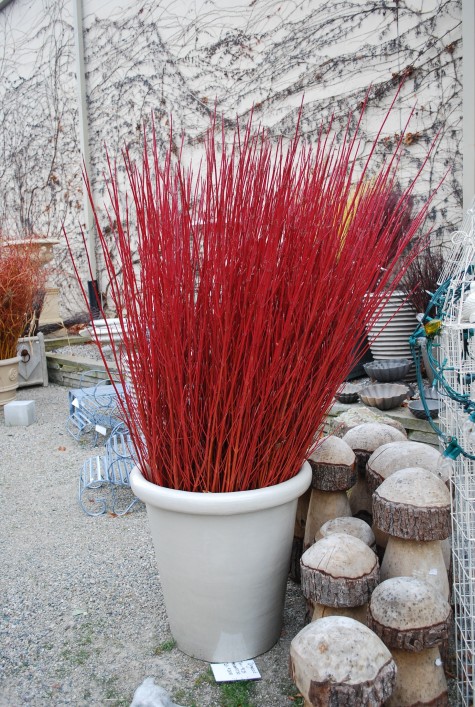 Whatever you might fancy, the dormant garden has plenty to recommend it. The gathering of materials, and the act of decorating for the cold season is an act of Mitchell-esque defiance I can get right behind.
Whatever you might fancy, the dormant garden has plenty to recommend it. The gathering of materials, and the act of decorating for the cold season is an act of Mitchell-esque defiance I can get right behind.
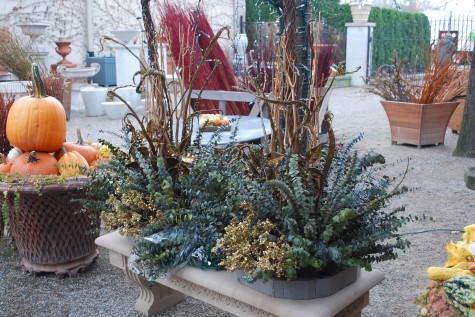
These arrangements are the first of the season out the door. The color is subtle, and most of ther materials natural. The preserved eucalyptus will perform just fine outdoors. The forms are constructed such that my client has only to drop them in her pots, and level them. She is ready and looking forward to the new season.

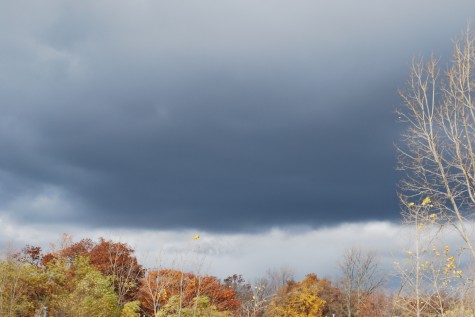








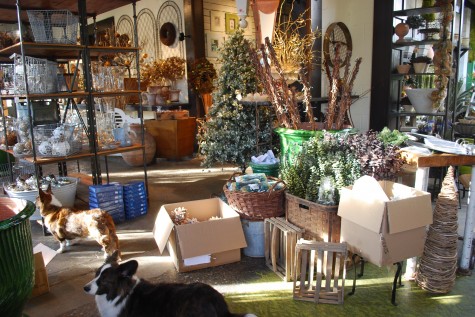 Though I shopped this past January for the holiday, and most everything was here this past August, I am never ready for what it really takes to change seasons. Have you ever? Even the corgis have that slightly appalled look on their faces. I am certain that the 10,000 square feet I have to deal with is secretly multiplying in the dead of night. It seems that everything needs to get moved-at least twice. Spaces have to be cleared-and of course cleaned-before they can be re-imagined. Sometimes it seems like my imagination will never ignite. When that everything involves stone, steel and lead, I have been known to daydream about being in the stamp-collecting business.
Though I shopped this past January for the holiday, and most everything was here this past August, I am never ready for what it really takes to change seasons. Have you ever? Even the corgis have that slightly appalled look on their faces. I am certain that the 10,000 square feet I have to deal with is secretly multiplying in the dead of night. It seems that everything needs to get moved-at least twice. Spaces have to be cleared-and of course cleaned-before they can be re-imagined. Sometimes it seems like my imagination will never ignite. When that everything involves stone, steel and lead, I have been known to daydream about being in the stamp-collecting business.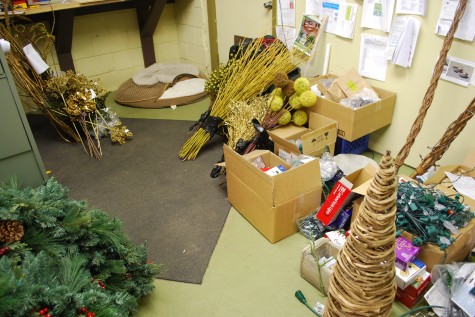 Rob likes everything imaginable in front of him all at once. The disaster that is his desk-loaded with messages, invoices, catalogues, notes, and all manner of other bits, spreads to the floorspace like a slime mold on steroids. This week he has been working away on the last of my leftover Halloween candy; the combination of his blood sugar level and his natural propensity to disorder defies description. Suffice it to say, I am living in a universe tending towards dissolution.
Rob likes everything imaginable in front of him all at once. The disaster that is his desk-loaded with messages, invoices, catalogues, notes, and all manner of other bits, spreads to the floorspace like a slime mold on steroids. This week he has been working away on the last of my leftover Halloween candy; the combination of his blood sugar level and his natural propensity to disorder defies description. Suffice it to say, I am living in a universe tending towards dissolution.  The greenhouse fernery, so gorgeous a week ago, is now bulging with all those things that have lost their homes, and have no place to go. An impossibly delicate terra cotta pot with applied roses from Espace Buffon in Paris is one of a hundred fragile items crowding my office conference table. What floor space is still available makes walking through any room, objects in tow, nervewracking. Should anyone out there know of a small scale hovercraft rated for interior use, please let me know.
The greenhouse fernery, so gorgeous a week ago, is now bulging with all those things that have lost their homes, and have no place to go. An impossibly delicate terra cotta pot with applied roses from Espace Buffon in Paris is one of a hundred fragile items crowding my office conference table. What floor space is still available makes walking through any room, objects in tow, nervewracking. Should anyone out there know of a small scale hovercraft rated for interior use, please let me know.  The rear portion of the shop is a cavernous garage-at least it seemed that way when I bought the building in 1995. Today every square foot has something going on, and not in any particular order. The arrangement of boxes so neatly shelved and stored has become completely unglued. The corgis treat this space like a formula one course, fraught with hairpin turns and unexpected obstructions. Great fun for them-not so much for me. This space needs to be shovelled out soon, such that we have room for the crew and materials necessary to construct of all our winter and holiday decor.
The rear portion of the shop is a cavernous garage-at least it seemed that way when I bought the building in 1995. Today every square foot has something going on, and not in any particular order. The arrangement of boxes so neatly shelved and stored has become completely unglued. The corgis treat this space like a formula one course, fraught with hairpin turns and unexpected obstructions. Great fun for them-not so much for me. This space needs to be shovelled out soon, such that we have room for the crew and materials necessary to construct of all our winter and holiday decor. 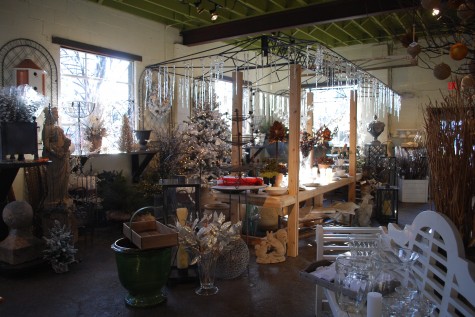 Progress has been made; certain big gestures are in place. Every box I unpack, I hope I remember what I was thinking when I bought ,works out. My idea of holiday has everything to do with materials and references to the garden. This part is simple. It takes a great deal of concentration to shop materials from 30 or better vendors such that you end up with a cohesive collection; this is only the beginning. Remembering what I had in mind over 10 months ago-even my notes don’t ring any bells. The materials pile up faster than I can do display; just this morning a semi truckload of twigs arrived. At this moment, the driveway is impassable.
Progress has been made; certain big gestures are in place. Every box I unpack, I hope I remember what I was thinking when I bought ,works out. My idea of holiday has everything to do with materials and references to the garden. This part is simple. It takes a great deal of concentration to shop materials from 30 or better vendors such that you end up with a cohesive collection; this is only the beginning. Remembering what I had in mind over 10 months ago-even my notes don’t ring any bells. The materials pile up faster than I can do display; just this morning a semi truckload of twigs arrived. At this moment, the driveway is impassable. 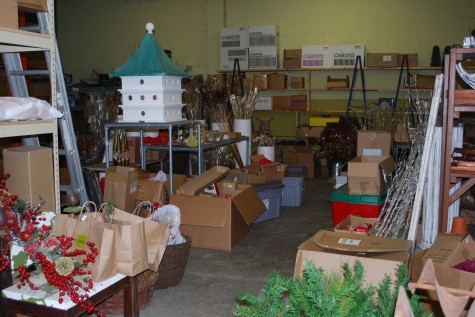
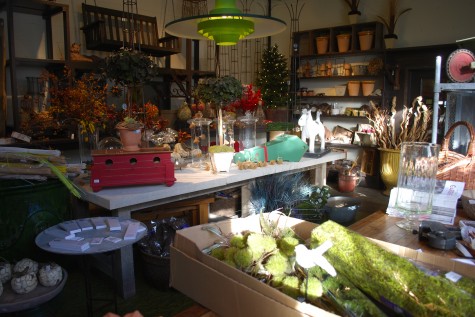 Next week Thursday November 12th is our deadline. We host an evening holiday preview and shopping soiree for our clients. Our 4pm to 9pm event ran until 11:30 last year. We serve a little something to eat and drink; lots of people come, and we have a great time. We aim for picture perfect, we are 6 days out and counting. I don’t see how we will be ready this minute, but somehow we will get there. Stop in, should you have a chance.
Next week Thursday November 12th is our deadline. We host an evening holiday preview and shopping soiree for our clients. Our 4pm to 9pm event ran until 11:30 last year. We serve a little something to eat and drink; lots of people come, and we have a great time. We aim for picture perfect, we are 6 days out and counting. I don’t see how we will be ready this minute, but somehow we will get there. Stop in, should you have a chance.